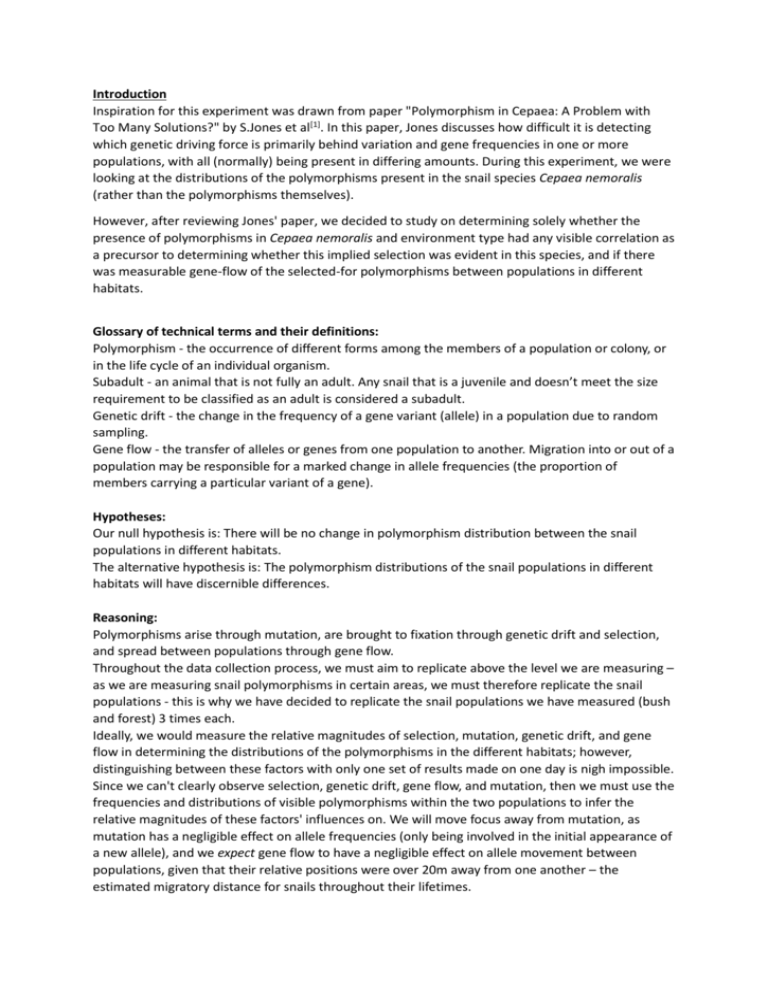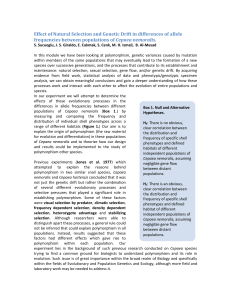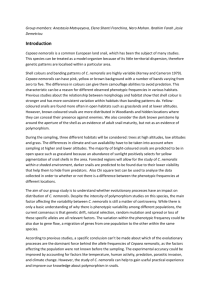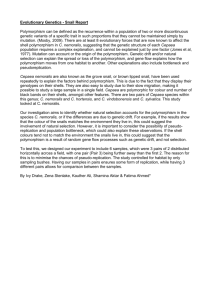Finished report for Cepaea polymorph distribution
advertisement

Introduction Inspiration for this experiment was drawn from paper "Polymorphism in Cepaea: A Problem with Too Many Solutions?" by S.Jones et al[1]. In this paper, Jones discusses how difficult it is detecting which genetic driving force is primarily behind variation and gene frequencies in one or more populations, with all (normally) being present in differing amounts. During this experiment, we were looking at the distributions of the polymorphisms present in the snail species Cepaea nemoralis (rather than the polymorphisms themselves). However, after reviewing Jones' paper, we decided to study on determining solely whether the presence of polymorphisms in Cepaea nemoralis and environment type had any visible correlation as a precursor to determining whether this implied selection was evident in this species, and if there was measurable gene-flow of the selected-for polymorphisms between populations in different habitats. Glossary of technical terms and their definitions: Polymorphism - the occurrence of different forms among the members of a population or colony, or in the life cycle of an individual organism. Subadult - an animal that is not fully an adult. Any snail that is a juvenile and doesn’t meet the size requirement to be classified as an adult is considered a subadult. Genetic drift - the change in the frequency of a gene variant (allele) in a population due to random sampling. Gene flow - the transfer of alleles or genes from one population to another. Migration into or out of a population may be responsible for a marked change in allele frequencies (the proportion of members carrying a particular variant of a gene). Hypotheses: Our null hypothesis is: There will be no change in polymorphism distribution between the snail populations in different habitats. The alternative hypothesis is: The polymorphism distributions of the snail populations in different habitats will have discernible differences. Reasoning: Polymorphisms arise through mutation, are brought to fixation through genetic drift and selection, and spread between populations through gene flow. Throughout the data collection process, we must aim to replicate above the level we are measuring – as we are measuring snail polymorphisms in certain areas, we must therefore replicate the snail populations - this is why we have decided to replicate the snail populations we have measured (bush and forest) 3 times each. Ideally, we would measure the relative magnitudes of selection, mutation, genetic drift, and gene flow in determining the distributions of the polymorphisms in the different habitats; however, distinguishing between these factors with only one set of results made on one day is nigh impossible. Since we can't clearly observe selection, genetic drift, gene flow, and mutation, then we must use the frequencies and distributions of visible polymorphisms within the two populations to infer the relative magnitudes of these factors' influences on. We will move focus away from mutation, as mutation has a negligible effect on allele frequencies (only being involved in the initial appearance of a new allele), and we expect gene flow to have a negligible effect on allele movement between populations, given that their relative positions were over 20m away from one another – the estimated migratory distance for snails throughout their lifetimes. Justifying the method We have reduced the variables by only sampling 2 habitats and repeating the conditions of the measurements we will make; our method replicates 2 types of snail population 3 times each. All snail populations were expected to be far enough apart to consider gene flow’s effects negligible between populations. The diagram is unrepresentative of the site – the populations we measured were all at (roughly) the same altitude, with 3 being in bush, and 3 being in forest directly across from bush sites. Results: Caption: The Distribution of C. nemoralis across two different habitats on the Marlborough Downs. We performed a Chi Squared statistical test to investigate if there was a significant difference in the distributions of 0-3 banded and 4-5 banded snails in the different habitats, bush and forest. Our Chi Squared value was 6.952 which is above the critical value for one degree of freedom. This means we were are unable to reject our null hypothesis for this experiment. Looking at the Raw Data from the table we can clearly see that the most frequent category was yellow 4-5 banded across all habitats and generations but had almost half the predominance in Bush rather than Forest. We found no un-banded Yellow or Brown snails so the only un-banded snails we found were pink. There was little significant difference between distributions in each of the habitats except that there were more 0-3 banded snails in the bush habitat compared to forest. We found significantly less sub adults (dead or alive) than adults and there were very few live specimens in our samples. Discussion: The rejection of the alternative hypotheses infers there is no difference in polymorph frequencies across the different samples. One possible reason for this homogenised distribution of polymorph frequencies is gene flow between each sample where the length of migration was underestimated in the original sampling design. Genetic drift could also explain the variation between the samples as stochastic change can create almost any result, however as drift has a tendency to fix alleles and the results show several different polymorphic phenotypes, it can be thought that its effects were negligible compared to gene flow. Geographical selection pressures appear to have had much the same effect on all of our samples as the frequencies were similar regardless of location, however the polymorphism frequencies within each of our samples suggests a different selection pressure affecting them all equally. Yellow, 4/5-banded shells were predominant in almost every one of our samples across all habitats but were never more than 2/3rds of the whole sample. This could be explained by frequency-dependant selection by predators (such as passerine birds [3]), maintaining the rare polymorphs by preferring to predate the most common ones. It is of note that this predominance lessened in the more open bush habitat, perhaps explained by the same predators, affecting all of the samples, being able to spot their preferred morph (yellow,4/5-banded) more easily. Again this frequency of yellow, 5-banded snails being the most common within each sample could also be explained by genetic drift, but drifts random nature would logically infer different intra-sample frequencies which are not shown by the data, it may be responsible for the greater diversity in all of the other phenotypes. Gene flow could be introducing the other morphs at a low frequency from an unknown source. Such a source may have been found had our experiment had more replication; however with just 3 and 3 replicates in each habitat the overall strength of our data is poor. More samples could have helped us distinguish the randomness of drift from selection and gene flow. Larger spacing between samples may have helped reduce pseudo-replication and the effect of gene flow. In a follow up experiment, with similar limitations on replication, we may sample only one habitat, increasing replication and our control on variables. Temperature has been shown to have differential effects on different shell types [2] but we only sampled on a cool autumn day. Whilst this is constant for our samples (we controlled at a constant altitude for similar microclimates) the day’s weather may have caused us to collect an unusual sample. Another factor which needs to be accounted for is that we predominantly collected dead snail shells. Whilst dead shells do lessen the effects of our weather bias (by showing snails alive during previous climatic conditions) there is a chance that the shells were deposited in their collected locations not due to the snails movement but due to other biotic (e.g. predators) or abiotic (e.g. wind) factors. The shells were often bleached heavily by the sun making phenotype determination more ambiguous and increasing experimental error. Whilst our results of similar overall morph frequencies infer a combination of gene flow and frequency-dependant selection while ruling out the effects of strong drift by a lack of randomness and fixed alleles, it cannot single out one of these three factors as the sole distributor of the polymorphic frequencies. Jones et al [1] explains that the polymorphic distribution in Cepaea is a problem explained by many non-mutually exclusive evolutionary forces. Bibliography: [1] Jones, J. S., Leith, B.H., and Rawlings, P. Polymorphism in Cepaea: A problem with too many solutions? Ann. Rev. Ecol Syst. 1977;8:109-104 [2]Allen, J. A. 1976. Further evidence for apostatic selection by wild passerine birds-9: 1 experiments. Heredity 36: 173-80 [3]Heath, D. J. 1975. Colour, sunlight and internal temperatures in the land snail Cepaea nemoralis (L.). Oecologia 19: 29-38
![Evo_Gen_Group_Introfinal_draft_[1.2]](http://s3.studylib.net/store/data/006798616_2-2ab0c6a2225107e0fac598a2105db405-300x300.png)






